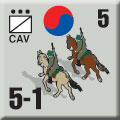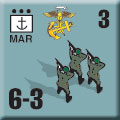| The Korean War Project
by Mike Bennighof, Ph.D.
November 2022
 The Korean War had not yet ended in October 1951 when U.S. News & World Report labeled it the “Forgotten War,” a tag that’s been re-used endlessly since, usually without attribution. Panzer Grenadier is a game of World War II tactical combat, but some time back we decided to take it to the Korean War as well. That conflict used the same weapons and tactics as seen in the last months of the Second World War, so the game engine translates very easily. The Korean War had not yet ended in October 1951 when U.S. News & World Report labeled it the “Forgotten War,” a tag that’s been re-used endlessly since, usually without attribution. Panzer Grenadier is a game of World War II tactical combat, but some time back we decided to take it to the Korean War as well. That conflict used the same weapons and tactics as seen in the last months of the Second World War, so the game engine translates very easily.
Pusan Perimeter, covering the first stages of the war, came out in 2014 and Counter Attack, with the breakout from the Perimeter and the landing at Inchon, joined it in 2017. Both originally appeared as boxed games, designed by Jay Townsend, with Pusan Perimeter sporting 48 scenarios and Counter Attack a whopping 65 of them.
 We’re going to transition both games into Playbook format, just like we have with many other Panzer Grenadier games. That allows us to avoid at least some of the price increases forced on us by rising costs of printing and shipping, and it’s also a much handier format to keep games in stock. We’re going to transition both games into Playbook format, just like we have with many other Panzer Grenadier games. That allows us to avoid at least some of the price increases forced on us by rising costs of printing and shipping, and it’s also a much handier format to keep games in stock.
Despite the “Forgotten War” tag, there’s a pretty rich historiography available on the war, at least regarding the U.S. and South Korean side. Yet the war still has less visibility in the popular imagination, or in wargames, that the massive conflict that ended just five years prior. The Playbook format lets us weave in much more of that history; the Korean War may not truly be “forgotten,” but there’s a lot of its story that needs to be told.
The Korean War’s a clearly-defined topic, and that lets us build the story of the Korean War around those two games. It’s a model we’ve used before, and it’s the standard pattern for the role-playing end of the game industry (it even has a name, the “core-supplement model.”). Pusan Perimeter and Counter Attack give us a great core, and now we get to expand them. Let’s have a look at how we plan to do that.
Pusan Perimeter
 Pusan Perimeter, as the older of the two games, pre-dates our adoption of the story-arc structure with its battle games to link the scenarios together. I want all of our games to match the very best we can offer, and so Pusan Perimeter will receive a rather thorough revision of its scenarios. They’ll be grouped into chapters so they help tell the story of the campaign, and then you’ll have a battle game to measure your performance in playing those scenarios. Pusan Perimeter, as the older of the two games, pre-dates our adoption of the story-arc structure with its battle games to link the scenarios together. I want all of our games to match the very best we can offer, and so Pusan Perimeter will receive a rather thorough revision of its scenarios. They’ll be grouped into chapters so they help tell the story of the campaign, and then you’ll have a battle game to measure your performance in playing those scenarios.
The current Pusan Perimeter scenario book is only 44 pages long, which I’ll grant is much longer than the typical wargame from other publishers including just a dozen scattershot scenarios with little connection between them. That leaves us with plenty of additional real estate to fill with battle games and historical background text (right now, Pusan Perimeter has none, but this will change). This is going to make for a very fine package of game play and history, all rolled together.
Counter Attack
 Counter Attack, in contrast, has a scenario book that’s simply too large for easy translation into Playbook format. And at 68 scenarios, it’s into the zone where players start to balk at so many of them in one game (“I’ll never play them all!”) rather than look excitedly at all the play opportunities. Counter Attack does have chapter structure and battle games, which is good, but I think it could do with some more detailed historical text (which runs short because of all those scenarios – it’s getting close to the maximum size we can print of that type of book, what’s known as saddle-stitched in the trade or “stapled” to normal people). Counter Attack, in contrast, has a scenario book that’s simply too large for easy translation into Playbook format. And at 68 scenarios, it’s into the zone where players start to balk at so many of them in one game (“I’ll never play them all!”) rather than look excitedly at all the play opportunities. Counter Attack does have chapter structure and battle games, which is good, but I think it could do with some more detailed historical text (which runs short because of all those scenarios – it’s getting close to the maximum size we can print of that type of book, what’s known as saddle-stitched in the trade or “stapled” to normal people).
So here’s what we’ll do with Counter Attack. We’re going to shave off the last two chapters, which total 13 scenarios, into a separate Campaign Study called 38th Parallel. That will leave Counter Attack with 52 scenarios, which is still a great many, and open up enough space to bulk up the history content.
38th Parallel
A Campaign Study, 38th Parallel has two chapters (the last two from Counter Attack) with thirteen scenarios and some additional historical text for each of the chapters. The featured event is, of course, the crossing of the 38th Parallel by United Nations forces following the successful landings at Inchon and recapture of Seoul.
Chosin Reservoir
 The best-known battle of the Korean War is the subject of Jay Townsend’s expansion book, which also introduces the People’s Liberation Army (known to the United Nations as the Chinese Communist Forces, or CCF) to Panzer Grenadier. It’s an expansion for Counter Attack, drawing on that game for maps and pieces and adding 128 more pieces (most of them Chinese). The Chinese aren’t lavishly-equipped like the Americans or even the NKPA but they have a wealth of combat experience. They’re facing the 1st Marine Division, conducting its epic anabasis away from the reservoir. This is the kind of story we can tell very effectively in this format; it just sort of pours itself into the structure. The best-known battle of the Korean War is the subject of Jay Townsend’s expansion book, which also introduces the People’s Liberation Army (known to the United Nations as the Chinese Communist Forces, or CCF) to Panzer Grenadier. It’s an expansion for Counter Attack, drawing on that game for maps and pieces and adding 128 more pieces (most of them Chinese). The Chinese aren’t lavishly-equipped like the Americans or even the NKPA but they have a wealth of combat experience. They’re facing the 1st Marine Division, conducting its epic anabasis away from the reservoir. This is the kind of story we can tell very effectively in this format; it just sort of pours itself into the structure.
Battles for Seoul
The two core games (Pusan Perimeter and Counter Attack) are centered on American battles against the North Koreans. The ROKs (South Korean Army) show up and fight alongside them, and sometimes on their own, but it’s an American story. I wanted to write more of the South Korean side (it is, after all, the Korean War). Battles for Seoul is a mix of scenarios and history, with its focus on the fighting between the ROK and NKPA.
And Beyond
The fighting in Korea came to an end three years after it began, with both sides settling in along a De-Militarized Zone that roughly followed the pre-war line of demarcation. There would be no victory parades by either side, and there still as of this writing (November 2022) is no peace treaty formally ending the war.
During those three years, there are many more stories that need to be told: the experiences of the other United Nations forces, like the Commonwealth Division or the Turkish Brigade. Fiercely-fought battles like the Imjin River or Heartbreak Ridge. The ROK 9th Infantry Division’s epic stand on White Horse Mountain.
We need to tell those stories. And with our pair of Korean War games, we have the means to do that.
Click here to join the Gold Club
See your Gold Club Insider newsletter for ordering information.
Sign up for our newsletter right here. Your info will never be sold or transferred; we'll just use it to update you on new games and new offers.
Mike Bennighof is president of Avalanche Press and holds a doctorate in history from Emory University. A Fulbright Scholar and NASA Journalist in Space finalist, he has published a great many books, games and articles on historical subjects; people are saying that some of them are actually good.
He lives in Birmingham, Alabama with his wife, three children, and new puppy. He misses his lizard-hunting Iron Dog, Leopold.
Want to keep Daily Content free of third-party ads? You can send us some love (and cash) through this link right here.
|
